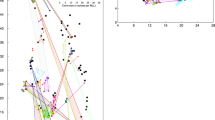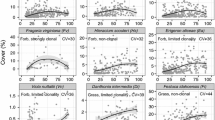Abstract
The vegetative propagation ofGlaux maritima is correlated with growth habit which is inturn related to the light environment. Plant form and vegetative behaviour were recorded 1980–1984 and an attempt to correlate this to population dynamics and vegetation development was made.
The type of vegetative propagation gives rise to a size hierarchy of propagules and thus a strong within clone dynamics. A range of life stages may be permanently present in a clone. Clones from different parts of a shore meadow have different patterns of vegetative propagation. The offshoot growth behaviour can be used to explain vegetation patterns and neighbour relationships.
Similar content being viewed by others
References
Ashmun, J. W. & Pitelka, L. F. 1984. Light induced variation in the growth and dynamics of transplanted ramets of the understory herb,Aster acuminatus. Oecologia 64: 255–262.
Binet, J. 1965. Action de la température et de la salinité sur la germination des grainesGlaux maritima (L.). Bul. Soc. Bot. Fr. 112: 346–350.
Jerling, L. 1988. Population dynamics ofGlaux maritima along a distributional cline. Vegetatio 74: 161–170.
Jerling, L. & Andersson, M. 1982. Effects of grazing by cattle on the reproduction ofPlantago maritima. Holarct. Ecol. 5: 405–411.
de, Jong, P., Aarsen, L. W. & Turkington, R. 1983. The use of contact sampling in studies of association in vegetation. J. Ecol. 71: 545–559.
Kershaw, K. A. 1964. Quantitative and dynamic ecology, Arnold, London.
Pitelka, L. F., Stanton, D. S. & Peckenham, M. O. 1980. Effects of light and density on resource allocation in a forest herb.Aster acuminatus. Am. J. Bot. 67: 942–948.
Ranwell, D. S. 1972. Ecology of salt marshes and sand dunes. Chapman & Hall, London.
Raunkiaer, C. 1934. The life forms of plants and statistical plant-geography. Oxford University Press, Oxford.
Rossiter, J. R. 1967. An analysis of annual sea level fluctuations in European waters. Geophy. J. Roy. Astron. Soc. 12: 259–299.
Slade, A. J. & Hutchings, M. V. 1987. The effect of nutrient availability on foraging in the clonal herbGlechoma hederacea. J. Ecol. 75: 95–112.
Tyler, G. 1971. Hydrology and salinity of Baltic sea shore meadows. Studies in the ecology of Baltic sea shore meadows III. Oikos 22: 1–20.
Warming, E. 1918. Om Jordudlöbere. K. Dansk. Vidensk. Skr. Afd. 8. R. II: 6.
Author information
Authors and Affiliations
Rights and permissions
About this article
Cite this article
Jerling, L. Clone dynamics, population dynamics and vegetation pattern ofGlaux maritima on a Baltic sea shore meadow. Vegetatio 74, 171–185 (1988). https://doi.org/10.1007/BF00044742
Accepted:
Issue Date:
DOI: https://doi.org/10.1007/BF00044742




